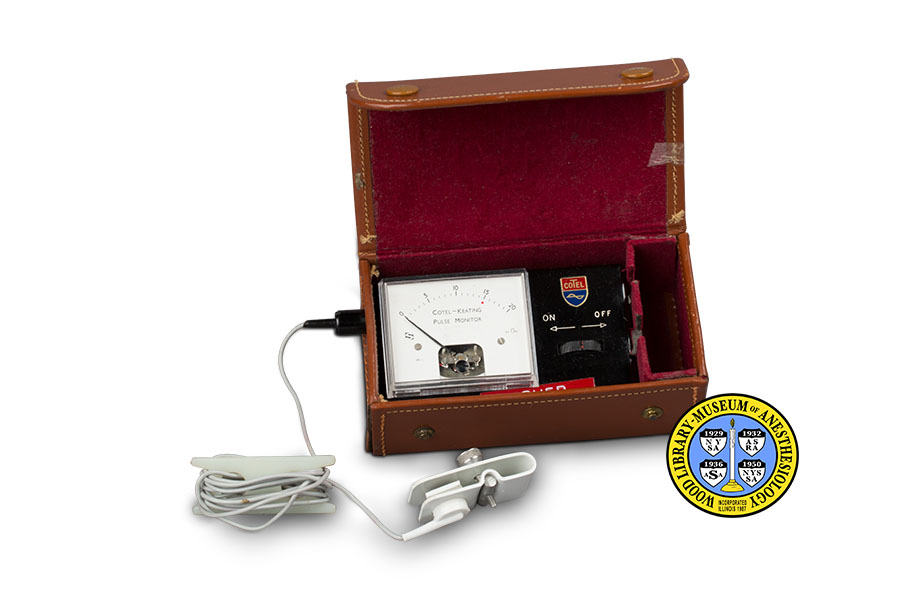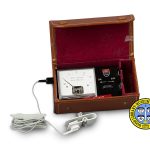Cotel-Keating Pulse Monitor
Anesthesiologists are responsible for monitoring and managing patient vital signs during surgery. Two of the first physicians to specialize in anesthesia were John Snow (1813-1858) and Joseph Clover (1825-1882). Both men carefully noted the effect of inhalation anesthetics on the pulse, which can indicate the depth of anesthesia, as well as warn of hemorrhage (excess bleeding) and other changes in the patient's condition. But keeping a hand on the patient's pulse throughout surgery was not always practical. Devices that could provide continuous, noninvasive monitoring of the pulse had been introduced by the 1930s.
British physician Victor J. Keating described the design of his pulse monitor in 1952. At that time, he was Lecturer in Anaesthetics at University College of the West Indies in Kingston, Jamaica. Dr, Keating later moved to London, working at St. Charles Hospital and the Royal Eye Hospital. By 1961, his monitor was being manufactured by J. G. Coates Ltd., in Burnley, Lancashire, England, under the brand name CoTel. It uses a crystal (piezoelectric) microphone to convert the sound of the pulse into an electrical signal. The device was used both for clinical monitoring and in research. Although some questioned their accuracy, Cotel-Keating pulse monitors continued in use for over a decade. In the 1980s a new technology, pulse oximetry, supplanted simpler pulse meters.
Catalog Record: Cotel-Keating Pulse Monitor
Access Key: amxv
Accession No.: 2013-01-22-2 C
Title: Cotel-Keating Pulse Monitor.
Title variation: Alt Title
Title: Cotel-Keating Pulse Indicator.
Title variation: Alt Title
Title: Cotel-Keating Cardiac Pulse Monitor.
Title variation: Alt Title
Title: Cotel-Keating Pulse Recorder.
Title variation: Alt Title
Title: Cotel-Keating Pulse Meter.
Publisher:
Physical Descript: 1 pulse monitor : metals, plastics, textiles, leather ; 6 x 16.5 x 9.5 cm.
Subject: Pulse – instrumentation.
Subject: Blood Circulation – instrumentation.
Subject: Monitoring, Physiologic – instrumentation.
Note Type: General
Notes: The monitor is described in the following orientation: the front is that side
on which the lid opens and closes. The controls inside the case face the user
and the electrode receptacle is on the left. The dimensions given are those
with the lid standing completely upright, the jack inserted in the receptacle
and the cord fully extended.
The 1963 article by Keating refers to a different model than the one
described in this record. The Wood Library-Museum owns an example of that
model, also.
Note Type: Citation
Notes: Beddard JRJ. Peripheral pulse amplitude in halothane anesthesia
[correspondence]. Br J Anaesthesia. June, 1965; 37(6):557.
Note Type: Citation
Notes: Brown KR, Keating V. Pulse monitor in ocular surgery. Br J Ophthalmol.
1963;47:184-185.
Note Type: Citation
Notes: J. G. Coates (Burnley), Ltd. website. https://www.cotel.co.uk/t/about-us.
Accessed July 1, 2016.
Note Type: Citation
Notes: Keating VJ. A simple pulse indicator. Br Med J. May 31, 1952;1:1188.
Note Type: Citation
Notes: Keating VJ. Drip feed for divinyl ether ampoules. Anaesthesia. July,
1953;8(3):197-198.
Note Type: Citation
Notes: Montagne J. Un nouveau moyen de controle a la disposition de
l’anesthesiologiste le Cotel Keating cardiac pulse monitor. Anesth Analg
(Paris). April-June 1961;18(2):405-12.
Note Type: Citation
Notes: Strauss S, Weisglass L, inventors. Pulse frequency and intensity meter. US
patent 2114578. April 19, 1938.
Note Type: Physical Description
Notes: One pulse monitor; When closed, the leather case measures 6 x 16.5 x 9.5
centimeters; The lid is integral to the case, with a single flap that folds
over the front panel of the case and closes with two painted metal snap
buttons; All edges of the case and lid are stitched with a heavy cotton
thread; The lid of the case is stamped in gold: “COTEL-KEATING [new line]
PULSE MONITOR [new line] COATES [new line] BURNLEY”, followed by
shield-shaped logo marked “CoTel”; The left side of the case has a round
opening to access the electrode receptacle; There is a threaded receptacle in
the bottom of the case that suggests there may be one or more parts missing
from this example; The case is lined with red velveteen, and is divided into
two compartments;
The compartment on the left is occupied by needle gauge, marked from “0” to
“20” in five-degree increments; A red dot is painted below the number “15”;
Below the range of numbers it is marked “COTEL-KEATING [new line] PULSE
MONITOR”; Below the number “0” there is a symbol or logo featuring the
letter “S”, and below this are printed the numbers “7/8-1”; Below the number
“20” is the number “22” followed by a symbol followed by “in”; Below all of
these marks, the white face of the gauge is cut away, revealing some of the
inner workings of the monitor; The gauge is covered with a removable,
transparent plastic shield; To the right of the gauge is a black plastic
housing that holds the control dial, marked with the CoTel logo, followed by
“ON”, underlined by a left directional arrow, and “OFF”, underlined by a
right directional arrow;
The compartment on the right stores an electrical cord with a finger clip at
one end and a jack at the other end; This jack connects to the body of the
device through a receptacle on the left side of the device; The clip measures
3 x 2.5 x 7 centimeters, and has four components: a strip of plastic bent to
a tight U-shape and marked on top with the CoTel logo, a metal screw and post
that hold the clip in place, and a crystal microphone that connects to the
cord; When in use, the fllesh of the fingertip touches the microphone that is
affixed to the linner side of the clip, and the upper half of the clip
presses down on the fingernail; The electrical cord is attached to the
crystal microphone; The cord is threaded through a piece of flat plastic with
two openings, called a cord organizer, which is marked with the CoTel logo.
Note Type: Reproduction
Notes: Photographed by Mr. Steve Donisch, January 12, 2016.
Note Type: Historical
Notes: Anesthesiologists are responsible for monitoring and managing patient vital
signs during surgery. Two of the first physicians to specialize in anesthesia
were John Snow (1813-1858) and Joseph Clover (1825-1882). Both men carefully
noted the effect of inhalation anesthetics on the pulse, which can indicate
the depth of anesthesia, as well as warn of hemorrhage (excess bleeding) and
other changes in the patient’s condition. But keeping a literal hand on the
patient’s pulse throughout surgery was not always practical. Devices that
could provide continuous, noninvasive monitoring of the pulse had been
introduced by the 1930s.
British physician V. J. Keating described the design of his (or her) pulse
monitor in 1952. At that time, Keating was Lecturer in Anaesthetics at
University College of the West Indies in Kingston, Jamaica, and the following
year ranked as Senior Anaesthetist there. By 1963, Keating had moved to
London, England, and worked at both the St. Charles Hospital and the Royal
Eye Hospital. This change of residence may account for the apparent delay in
the commercial production of the monitor. The cataloger has found no further
biographical details about the inventor.
By 1961, Keating’s monitor was being manufactured by J. G. Coates Ltd., in
Burnley, Lancashire, England, under the brand name CoTel. It uses a crystal
(piezoelectric) microphone to translate the sound of the pulse into an
electrical signal. This too, was not new. Physiological monitors that
employed a crystal microphone for this purpose had been also been in use
since the 1930s.
The WLM owns two quite different models of the monitor. That described in
this record is more sophisticated than the one described by Keating and Brown
in 1963, and is likely to have been made at a somewhat later date. These
devices were used both for clinical monitoring and in research. Although some
questioned their accuracy (see Campbell et al., 1964, and Beddard, 1965),
Cotel-Keating pulse monitors continued in use for over a decade.
Note Type: Publication
Notes: Campbell JR, Lawson DD, Sanford J. The use of pulse monitors in dogs and cats
J Small Animal Practice. June, 1964;5(3):255-257.
Note Type: Publication
Notes: Flintsch K. Der Cotel-Keating pulsanzeiger. Munch Med Wochenschr. October 20,
1964;106:1781-2.
Note Type: Publication
Notes: Jochim K, Gaddas SF, Marquis H. A mobile unit for simultaneously recording
heart sounds, pulse tracing, and electrocardiogram. American Heart Journal.
June, 1937;13(6):731-735.
Note Type: Exhibition
Notes: Selected for the WLM website (noted January 4, 2016).


